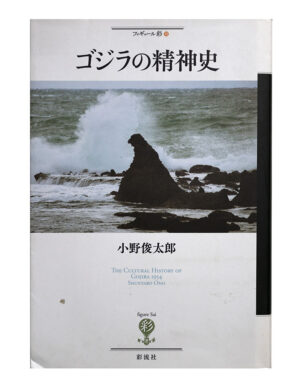2.22.2023
The Cultural History of Godzilla – Pt 31


P 79
数寄屋橋といえば今は交差点の名前などに残っているだけだが、二九年に建造された石造りの二重アーチの姿が有名だった。ラジオドラマから映画になった『君の名は』の舞台となったわけだが、菊田一夫はすれちがいメロドラマの傑作『哀愁』(一九四〇年)のウォータールー橋から着想を得た。数奇屋橋は東京オリンピックを控えて建築される東京高速道路のために五八年に撤去されてしまった。
Speaking of Sukiyabashi, it remains only in the name of the intersection now, but it was famous for the stone double arch that was built in 1929. Kazuo Kikuta got the idea from the Waterloo Bridge in the passing melodrama masterpiece “Sorrow” (1940). Sukiya Bridge was removed in 1958 for the construction of the Tokyo Expressway ahead of the Tokyo Olympics.
Waterloo Bridge (1940 film). Waterloo Bridge is a 1940 remake of the 1931 film of the same title, adapted from the 1930 play of the same title. The film was made by Metro-Goldwyn-Mayer, directed by Mervyn LeRoy and produced by Sidney Franklin and Mervyn LeRoy. The screenplay is by S. N. Behrman, Hans Rameau and George Froeschel, based on the Broadway drama by Robert E. Sherwood. The music is by Herbert Stothart and cinematography by Joseph Ruttenberg. (Source: Jisho.org)
その脇にあった日本劇場は三三年に建築されたもので、東宝にとって重要な拠点だった。映画だけでなく、ダンシングチームも有名で演劇やショーがおこなわれていた。進駐軍に接収されて「アーニ・・パイル劇場」と呼ばれていたこともあった。ちなみに渋谷東宝で観た作家の笹沢左保は、雪村いづみと渋東ダンシングチームによるショーと映画とが交替だったと証言している(『検証ゴジラ誕生』)。映画と歌謡ショーが共存するなかで、『ゴジラ』は鑑賞されていたのだ。じつはここまでの建物はもしも三三年にキングコングが上陸していたら蹂躙したり登ることもできた同時代の建物だった。
The Japanese theater next to it was built in 1933 and was an important base for Toho. Not only movies, but also the dancing team was famous, and plays and shows were held. It was once requisitioned by the Occupation Army and called the “Ernie Pyle Theater.” By the way, the writer Saho Sasazawa, who saw it at Shibuya Toho, testified that the show and the movie by Izumi Yukimura and the Shibuto Dancing Team alternated (“Inspection of the Birth of Godzilla”). “Godzilla” was appreciated while movies and music shows coexisted. In fact, the buildings up to this point were contemporary buildings that could have been run over and climbed if King Kong had landed in 1933.
日劇は八一年に隣にあった朝日新聞社本社とともに壊されて現在は有楽町マリオンになっている。これを破壊したのが八四年の『ゴジラ』だった。自分の側の日劇をゴジラの尻尾で壊すのが東宝の良心だとすれば、ライバルとなりうるテレビ塔は罪悪感もなく正面から壊してみせる。日本のテレビ放送の実験は幻の東京オリンピックの中継のために戦前に着手されていた。その後RCAなどの技術が入ってきて、NHKや日本テレビの本放送が前年の五三年に始まっていた。新藤兼人監督の再現映画『第五福竜丸』(一九五九年)でも、被爆した乗組員が入院した先の東京の病院にテレビが贈られて、故郷の焼津のようすを観る場面がある。まだまだ高価なものであるが、映画よりも速報性をもつ新しいメディアだった。
Nichigeki was demolished in 1981 along with the Asahi Shimbun headquarters next door, and is now Yurakucho Mullion. It was “Godzilla” in 1984 that destroyed this. If it is Toho’s conscience to destroy the Nichigeki on his side with Godzilla’s tail, then he will destroy the TV tower, which could be his rival, from the front without feeling guilty. Experiments in Japanese television broadcasting had been started before the war to relay the rare Tokyo Olympics. After that, technology such as RCA came in, and NHK and Nippon Television began full-scale broadcasting in 1953, the previous year. In Kaneto Shindo’s reenactment film The Daigo Fukuryu Maru (1959), there is a scene in which the crew members who were exposed to the atomic bombing were given a TV to the hospital in Tokyo where they were hospitalized, and they watch the scene in their hometown of Yaizu. It was still expensive, but it was a new medium with more immediate reporting than movies.

P 80
「ゴジラ」にもタイアップしたユタカテレビのテレビ受像機が姿を見せるし、テレビカメラを据えて「これは劇でも映画でもありません」と実況中継する放送局はNHKならぬGHKである。テレビだけでなくMS短波無線機でラジオの実況中に「さようなら皆さん」といってテレビ塔が倒される。このとき紀尾井町にはNHKの電波塔が、麹町には日本テレビの電波塔があった。両方ともその後五八年に建った東京タワーに地位を譲ってしまった。
Yutaka Television’s TV receiver, which has a tie-in with “Godzilla,” will appear, and the broadcasting station that will broadcast the live commentary “This is neither a play nor a movie” with a TV camera is GHK, not NHK. Not only the TV but also the MS shortwave radio, during the live broadcast of the radio, says “Goodbye everyone” and the TV tower is knocked down. At that time, there was a radio tower for NHK in Kioicho, and a radio tower for Nippon Television in Kojimachi. Both later gave up their positions to Tokyo Tower, which was built in 1958.
現在の国会議事堂は三六年に竣工したものだ。ゴジラ対策をめぐっての国会内部の混乱の様子も描かれているが、それが「改正警察法」つまり警察予備隊の創設をめぐる「乱闘国会」を反映しているように受け取られた。
The current parliament building was completed in 1936. The confusion inside the Diet over the Godzilla countermeasures is also drawn, but it was received as if it reflected the “Revised Police Law,” that is, the “Melee Diet” over the establishment of the National Police Reserve.
最後にゴジラは勝鬨橋の画面から右側の月島寄りの橋をもちあげて、なぎ倒す。威勢のよい名前をもつ勝鬨橋だが、四〇年に月島地区で開催される予定で幻に終わった東京万博の会場へと結ぶために建設された。まさに皇紀二六〇〇年の記念となる象徴的な建造物であった。東洋一を自負した可動橋だが現在は開かずの橋となっている。すぐそばには放射能マグロを埋めた東京築地市場がある。
Finally, Godzilla lifts up the bridge near Tsukishima on the right side of the screen of Kachidoki Bridge and knocks it down. Kachidoki Bridge has a lively name, but it was built to connect to the site of the Tokyo Expo, which was to be held in the Tsukishima area in 1940, but ended in illusion. It was truly a symbolic building commemorating the 2600th anniversary of the Imperial era. Although it boasted to be the best movable bridge in the East, it is currently closed. Nearby is Tokyo Tsukiji Market, where radioactive tuna is buried.
この勝鬨橋が破壊されるようすを山根博士や尾形とともに眺めていた新吉が、「ちくしょう」と口にする。最初は小声だったが、しだいに周囲にも広がっていく。勝鬨ならぬ悪罵だろう。もちろん「ちくしょう」とは人間ではないという意味だが、「畜生」であるゴジラに対する悪罵として適切だ。それに「鬼畜米英」という戦時中の悪罵にも似ている。だが、同時にこれがゴジラの圧倒的な破壊力の前になすすべもない自分自身が「ちくしょう」でもあるという唇を噛むような悔しさの感情も含んでいるのだ。
Shinkichi, who was watching the destruction of this Kachidoki Bridge with Dr. Yamane and Ogata, uttered, “Fuck it.” It was whispered at first, but it gradually spread to the surroundings. It would be a swearing rather than a triumph. Of course, “bastard” means not human, but it’s an appropriate insult to Godzilla, who is a “beast.” It is also similar to the wartime insult called “Western brute.” However, at the same time, it also contains the feeling of bitterness and frustration that I am helpless against Godzilla’s overwhelming destructive power.
ちくしょう 1. damn it; damn; son of a bitch; for Christ’s sake; 2. beast; animal; 3. person reborn into the animal realm; 4. brute; bastard; 5. Animals in Buddhism. (Source: Jisho.org https://jisho.org/search/ちくしょう)